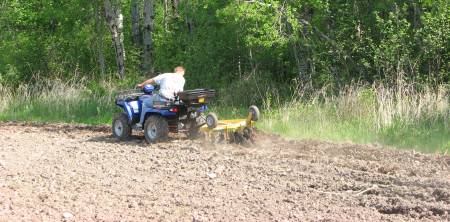
There are as many different kinds of food plot mixes on the market as there are days in a year, but a lot of people do not realize that the best food plots for white-tailed deer actually grow naturally! In my opinion, natural foods are the best food plots.
I guess by definition what I am writing about today can not really be considered food plots, but more like techniques to provide additional foods for deer. But I believe habitat management is the first step in deer management!
Disking– This is a simple technique that can be implemented (get it) during both the spring and fall. There is nothing magical about how disking works. The only thing necessary is that you use a disk to disturb the surface of the soil so that forb seeds can become “exposed” and germinate.
To promote warm season forbs for deer, disk the selected area before spring green-up. To promote cool season food plots simply disk the area where you would like your native food plot to be during late summer. In addition, to promote more edge and diversity you can alternate disked and undisked strips (strip disking).
Fire and Prescribed Burning – Just mentioning the word “fire” scares a lot of people, but if you do it right, prescribed burning can be very safe and be the most beneficial habitat management technique you ever use. Burning creates natural “food plots” for whitetail by returning the nutrients tied up in dead and dying organic matter to the ground and stimulating forb seeds found near the soil’s surface.
To promote forbs using fire, the single best time to burn would be in early fall as the very first cool fronts roll in. This allows much of the grass and other fine fuels to be removed from the land’s surface and really allows forbs to take off. In addition, you can used disked strips around the area around where you intended to burn as fire breaks. It’s a double whammy!
Deferred Grazing– This one is really stretching this whole food plot thing, but excluding or removing cattle from a particular area really can provide substantially more browse and forbs for white-tailed deer. Keep this mind and try rotating livestock on your property. You just might will be surprised at where you find the deer… in the areas where deferred grazing took place!
Great site! I am going to get my friends signed up for your newsletter!
Do you have any experience in maximizing browse by cutting almost through a small blackjack tree? When cutting it, have it
fall over and the tree will regrow out of the cut and thereby giving the deer new browse that they can reach to eat.
Yes, the technique, commonly called half-cutting, works great for creating deer browse. It can be done on any woody plant, but is ideal on trees and shrubs that are preferred by white-tailed deer.
The technique is simple: Cut the smaller tree/shrub about a foot or two from the ground, cut half way throught the trunk and bend it over. Not only will the tree survive and allow it’s current and future leaves to be availalbe to deer, but the plant may sprout new stems from the wound.
I would not recommend this technique on oak trees, however, especially in areas with oak wilt disease.
What is a good food plot mixture for South East Missouri?
DeerSlayer, try a mixture of 60 percent wheat and 40 percent brassicas (rape). This is a simple, yet effective, mix that will keep deer on your plots all winter long. It’s kind of a late start, but you can still give it a shot (if you are talking about for this year).
I have a 40 acres of woods in in south western Indiana. It has a big pond a small pond and is very hilly. Any ideas for a food plot? Size, mix, summer, fall?
What food is the best for deer in a food plot for eastern Iowa?
Mike, at this point in the season the most effective plot would simply be wheat planted at 100 pounds per acre.
These practices are often overlooked ways to promote natural foods in deer habitat. We are often sold on the fact that we must buy and plant seeds when the reality is that the seeds of all of the plants that deer eat are already found in the soil bank.